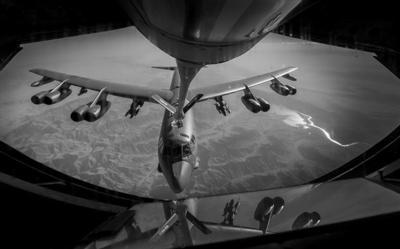23rd Bomb Squadron Traces Origins Back To 1917
Carrying out vital missions for over 100 years, the 23rd Bomb Squadron and the associated aircraft maintenance units continue to play a critical role in delivering combat airpower. Dating back to June 16, 1917, the 23rd BS honors 100 years of existence.

"This is a significant milestone in any squadron history by reaching the century mark,” said Lt. Col. Mike Maginness, the 23rd BS commander. “It’s particularly appropriate that the Bomber Barons here are spending our 100th dropping bombs in combat.”
Throughout the years, the 23rd BS has flown various aircraft; however, the B-52 Stratofortress has had a significant role for close to 65 years of that time. Although the B-52 initially had a 10-15 year airframe design, it has well surpassed expectations. Maginness added that because of its modular design, the B-52 is easily modifiable in order to eliminate new threats while also continuing to search for new weapons and tactics, pushing the capabilities of the aircraft to keep it pertinent to the fight. “We haven’t even gotten to the tip of the iceberg of what it’s capable of,” Maginness said. “There are many ideas and technological programs being worked right now to not only keep it operating as an important part of the fight for the next 30-40 years, but to ensure it’s the go-to aircraft for certain missions.”
Aircrews have proven they can adapt to the changes by continually delivering decisive airpower in combat. However, the dominance would not be possible without the support of the aircraft maintainers and munitions troops.
According to Maginness, the 23rd Aircraft Maintenance Unit set an all-time record for consecutive sorties without a maintenance cancellation. “This is a dual accomplishment of achievements for us,” said Capt. Steven Draughon, the 23rd AMU officer in charge. “Not only was it the 100th anniversary of the Bomber Barons, but at the end of the day we launched our 401st consecutive sortie.”
The 23rd AMU Airmen surpassed the previous record of 312 sorties, which was held during Operation Linebacker II in 1972 during the Vietnam War. To accomplish this milestone, the maintainers adapted from the frigid winter in Minot Air Force Base, North Dakota, to the hot desert environment in Southwest Asia. “The ability of these Airmen to adapt to brutal weather speaks volumes on the resiliency of each person out here,” Draughon said. “Transitioning from freezing temperatures around -45 degrees (Fahrenheit) to a sizzling 120 degrees (Fahrenheit) in a span of 90 days, they have still found the capability to continue to set all-time records for (quality) production.”
For Airman 1st Class Jacob Jewel, a 23rd AMU propulsions journeyman, there’s an abundance of components of the B-52 that could need attention each day, but he takes pride in knowing that his work directly contributes to the successful launch to “go do what they do.”
“Our adversaries should be afraid when they see the B-52s operating each day. Our dedication and hard work will never stop, and that’s a message we are sending,” Jewel added.
All assets of the 23rd BS from the maintenance teams, to the munitions teams, to the aircrew, will continue to deliver air power in various missions and locations; answering our nation’s call.
“It’s not about what we’ve done the last 100 years. It’s about the next 100,” Maginness said.
(Image provided with USAF news release)
 Aero-News: Quote of the Day (12.07.25)
Aero-News: Quote of the Day (12.07.25) ANN's Daily Aero-Linx (12.07.25)
ANN's Daily Aero-Linx (12.07.25) NTSB Final Report: Lafferty Jack Sea Rey
NTSB Final Report: Lafferty Jack Sea Rey Classic Aero-TV: The B29 SuperFortress Doc - History in Flight
Classic Aero-TV: The B29 SuperFortress Doc - History in Flight Airborne 12.08.25: Samaritans Purse Hijack, FAA Med Relief, China Rocket Fail
Airborne 12.08.25: Samaritans Purse Hijack, FAA Med Relief, China Rocket Fail



